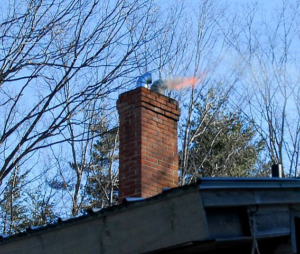All About Chimney Fires
The Facts About Chimney Fires

a chimney fire
Chimneys decorate the roofline of a home…
and they’re maintenance-free, right?
Aside from adding architectural interest to your home, a chimney’s real function is to carry dangerous gases from your fireplace, furnace, or wood stove, safely out of your home. Your fireplace and wood stove chimney should be properly maintained because the chimney’s function is to keep the air you breathe safely from toxic fumes. Your home, whether it’s new construction or it is hundreds of years old, still needs upkeep. A dirty chimney can put your family at risk for a chimney fire. A good chimney sweep is required to maintain a safe chimney.
What is a Chimney Fire?
A fire in your fireplace is very different from a chimney fire! Residential fireplaces that are properly built and maintained are designed to withstand continuous temperatures that are very hot (1000-2000 degrees Fahrenheit). Residential chimneys that are properly built and maintained are designed for continuous temperatures that are much less than that of the actual fireplace, (400-500). When chimneys are exposed to the extreme shock of a chimney fire they are often damaged.
Chimneys that are built and maintained properly shouldn’t experience chimney fires. A fire in your chimney is very destructive and it could cause the house to catch on fire and that is why the National Fire Protection Association Recommends that chimneys be inspected and swept as needed on no less than an annual basis.
There are Two Types of Chimney Fires:
A free burning chimney fire is one that is often associated with a lot of smoke and noise and there are often flames or sparks apparent at the top of the chimney. In plain words, “You and or your nearby neighbors know that you are having a “chimney fire”.
A slow-burning chimney fire is one that is often undetected because the conditions within the flue do not facilitate the same results as a free burning chimney fire.
Either one of these types of chimney fires is dangerous. If ever you suspect that there may be a fire up in the flue you should call the fire department immediately.
What Causes the Chimney Fire?
Creosote and soot in the flue is a major contributing cause of most chimney fires. Soot and creosote act as fuel for the fire within the chimney flue. When the conditions are just right, and a spark or flame is introduced up into the chimney, a chimney fire is often the result.
How do Chimney Fires “Hurt” the Chimney?
Masonry Chimneys
A chimney fire can damage your masonry chimney whether it is old or new. The extreme temperatures can melt the mortar and damage both terracotta and stainless steel linings. Terracotta linings often crack during chimney fires. Stainless steel linings often hold up better during chimney fires than most chimney lining materials, but they can become warped and brittle depending on the circumstances of the fire.
Pre-fabricated, factory-built metal chimneys
Tests require a chimney to withstand a flue temperature of up to 2100° Fahrenheit without sustaining any damage. Factory-built, metal chimneys designed to vent wood burning stoves or pre-fabricated metal fireplaces are required to pass tests in most jurisdictions in the U.S. If a pre-fabricated, factory-built metal chimney has been damaged by a fire, it should no longer be used and must be replaced.
Special Effects on Wood Stoves
A wood stove is made to contain a hot fire. The connector pipes running from the stove to the chimney cannot withstand the high temperatures produced during a chimney fire and can warp or separate from the vibrations created by air turbulence during a fire. If these pipes have been damaged, they must be replaced before using the unit again.
How to tell if You’ve Had a Chimney Fire
A chimney that has been damaged by a chimney fire, can put a home and its’ occupants at risk. You may not be aware that a chimney fire has occurred and that is why it is extremely important to have your chimney inspected by a CSIA Certified Chimney Sweep on a regular basis. A professional chimney sweep will inspect for:
- “Puffy” or “honeycombed” creosote
- Any warped metal of the damper, smoke chamber’s connector pipe or warping of the factory-built metal chimney
- Collapsed flue tiles, cracked tiles or any tiles that have large chunks missing from them
- A discolored or distorted rain cap
- A heat damaged TV antenna that is attached to the chimney
- Creosote flakes or pieces found either on the roof or on the ground
- Roofing materials that may be damaged by hot creosote
- Cracks in the exterior masonry of the chimney
- Evidence of smoke that has escaped through the joints in the mortar of your masonry, or tile liner
What do I do after a chimney fire?
After a chimney fire or a suspected chimney fire, you should have a thorough inspection of the chimney done by a professional chimney sweep. The inspection should include all accessible areas of the chimney structure both inside the home and “out”. The interior of the flue should be inspected with a video camera to document any defects. (*Damage that is the direct result of a chimney fire is often covered under homeowners insurance policies. “Antrim’s” is recognized by most major insurance companies as one of Southeastern Pennsylvania’s most professional and trustworthy chimney contractors. Subsequently, we work with insurance adjusters on a regular basis regarding chimney fire claims.)
Think that a chimney fire could have occurred at your house? call Antrim’s, A Good Sweep Chimney & Masonry Service for a professional evaluation, we have CSIA Certified Chimney Sweeps®. If you have damage from a chimney fire we know what will bring your system back into compliance with safety standards.

